The area between Wrottesley and Vlacq 
To see the full mosaic click here.
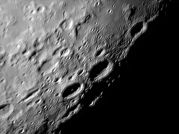 |
This is the northerly part of the mosaic and shows craters of quite different ages, ranging from
over 4,000 million to less than 1,000 million years old. The lower picture is a closer study of the southern part of the upper
picture. In the middle of this picture is a long, narrow feature which seems simply to be called Rheita E.
I feel that it must either have been formed by a grazing impact or, more likely, it is a series of interconnected craters.
The pictures were taken with a ToUcam attached to my LX200 on 1st September 2004,
when the Moon was 17.7 days old. The upper picture was taken at prime focus and the lower one with my X2 lens attached.
|
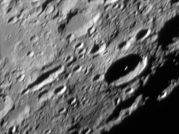 |
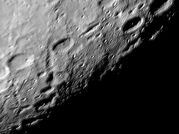 |
This is the centre part of the mosaic from Snellius in the north to Metius in the south.
The craters Rheita and Metius are unremarkable at 71 and 90 Km in diameter and some 3 to 4,000 metres deep. Starting
just to the west of Rheita is the northern end of the Rheita Valley which stretches for about 500 Km to the south-east and into the
terminator in the upper picture.
It is really composed of a string of overlapping small craters including the somewhat larger craters Young and Young D.
The pictures were taken with a ToUcam attached to my LX200 on 1st September 2004,
when the Moon was 17.7 days old. The upper picture was taken at prime focus and the lower one with my X2 lens attached.
|
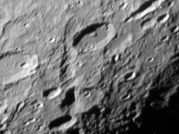 |
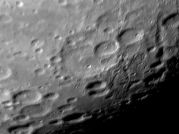 |
This is the lower section of the mosaic, showing the area between Rheita in the north
and Vlacq in the South. The largest crater, at 196 Km, and oldest, at 4,200 million years, is Janssen.
Overlaying it to the north is Fabricius, 80 Km in diameter, 2500 metres deep and only about 2,000 million years old.
On its northern edge is Metius, 90 Km across and 3000 metres deep and rather older at about 3,900 million years.
Vlacq, to the south, is another old crater at about 4,200 million years; it is 92 Km in diameter and 3000 metres deep.
The picture was taken with a ToUcam attached to my LX200 on 1st September 2004,
when the Moon was 17.7 days old.
|
Home Back to SE Quadrant

